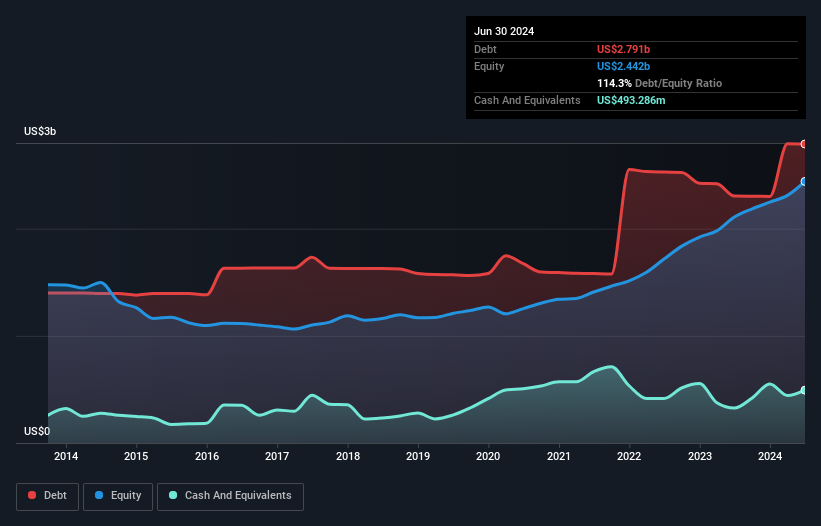- United States
- /
- Commercial Services
- /
- NYSE:CLH
These 4 Measures Indicate That Clean Harbors (NYSE:CLH) Is Using Debt Reasonably Well
David Iben put it well when he said, 'Volatility is not a risk we care about. What we care about is avoiding the permanent loss of capital.' So it might be obvious that you need to consider debt, when you think about how risky any given stock is, because too much debt can sink a company. Importantly, Clean Harbors, Inc. (NYSE:CLH) does carry debt. But the more important question is: how much risk is that debt creating?
Why Does Debt Bring Risk?
Debt and other liabilities become risky for a business when it cannot easily fulfill those obligations, either with free cash flow or by raising capital at an attractive price. In the worst case scenario, a company can go bankrupt if it cannot pay its creditors. However, a more usual (but still expensive) situation is where a company must dilute shareholders at a cheap share price simply to get debt under control. By replacing dilution, though, debt can be an extremely good tool for businesses that need capital to invest in growth at high rates of return. When we examine debt levels, we first consider both cash and debt levels, together.
See our latest analysis for Clean Harbors
What Is Clean Harbors's Debt?
You can click the graphic below for the historical numbers, but it shows that as of June 2024 Clean Harbors had US$2.79b of debt, an increase on US$2.30b, over one year. However, because it has a cash reserve of US$493.3m, its net debt is less, at about US$2.30b.

How Strong Is Clean Harbors' Balance Sheet?
According to the last reported balance sheet, Clean Harbors had liabilities of US$1.06b due within 12 months, and liabilities of US$3.63b due beyond 12 months. On the other hand, it had cash of US$493.3m and US$1.28b worth of receivables due within a year. So it has liabilities totalling US$2.92b more than its cash and near-term receivables, combined.
Clean Harbors has a very large market capitalization of US$12.9b, so it could very likely raise cash to ameliorate its balance sheet, if the need arose. But it's clear that we should definitely closely examine whether it can manage its debt without dilution.
We use two main ratios to inform us about debt levels relative to earnings. The first is net debt divided by earnings before interest, tax, depreciation, and amortization (EBITDA), while the second is how many times its earnings before interest and tax (EBIT) covers its interest expense (or its interest cover, for short). This way, we consider both the absolute quantum of the debt, as well as the interest rates paid on it.
Clean Harbors's net debt is sitting at a very reasonable 2.2 times its EBITDA, while its EBIT covered its interest expense just 5.2 times last year. While that doesn't worry us too much, it does suggest the interest payments are somewhat of a burden. Notably Clean Harbors's EBIT was pretty flat over the last year. We would prefer to see some earnings growth, because that always helps diminish debt. The balance sheet is clearly the area to focus on when you are analysing debt. But ultimately the future profitability of the business will decide if Clean Harbors can strengthen its balance sheet over time. So if you're focused on the future you can check out this free report showing analyst profit forecasts.
Finally, a company can only pay off debt with cold hard cash, not accounting profits. So we always check how much of that EBIT is translated into free cash flow. Looking at the most recent three years, Clean Harbors recorded free cash flow of 38% of its EBIT, which is weaker than we'd expect. That weak cash conversion makes it more difficult to handle indebtedness.
Our View
We weren't impressed with Clean Harbors's net debt to EBITDA, and its conversion of EBIT to free cash flow made us cautious. Balancing that a bit, it has a demonstrated ability level of total liabilities. Looking at all this data makes us feel a little cautious about Clean Harbors's debt levels. While we appreciate debt can enhance returns on equity, we'd suggest that shareholders keep close watch on its debt levels, lest they increase. The balance sheet is clearly the area to focus on when you are analysing debt. But ultimately, every company can contain risks that exist outside of the balance sheet. To that end, you should be aware of the 1 warning sign we've spotted with Clean Harbors .
If, after all that, you're more interested in a fast growing company with a rock-solid balance sheet, then check out our list of net cash growth stocks without delay.
New: AI Stock Screener & Alerts
Our new AI Stock Screener scans the market every day to uncover opportunities.
• Dividend Powerhouses (3%+ Yield)
• Undervalued Small Caps with Insider Buying
• High growth Tech and AI Companies
Or build your own from over 50 metrics.
Have feedback on this article? Concerned about the content? Get in touch with us directly. Alternatively, email editorial-team (at) simplywallst.com.
This article by Simply Wall St is general in nature. We provide commentary based on historical data and analyst forecasts only using an unbiased methodology and our articles are not intended to be financial advice. It does not constitute a recommendation to buy or sell any stock, and does not take account of your objectives, or your financial situation. We aim to bring you long-term focused analysis driven by fundamental data. Note that our analysis may not factor in the latest price-sensitive company announcements or qualitative material. Simply Wall St has no position in any stocks mentioned.
About NYSE:CLH
Clean Harbors
Provides environmental and industrial services in the United States and Canada.
Adequate balance sheet and fair value.
Similar Companies
Market Insights
Community Narratives





